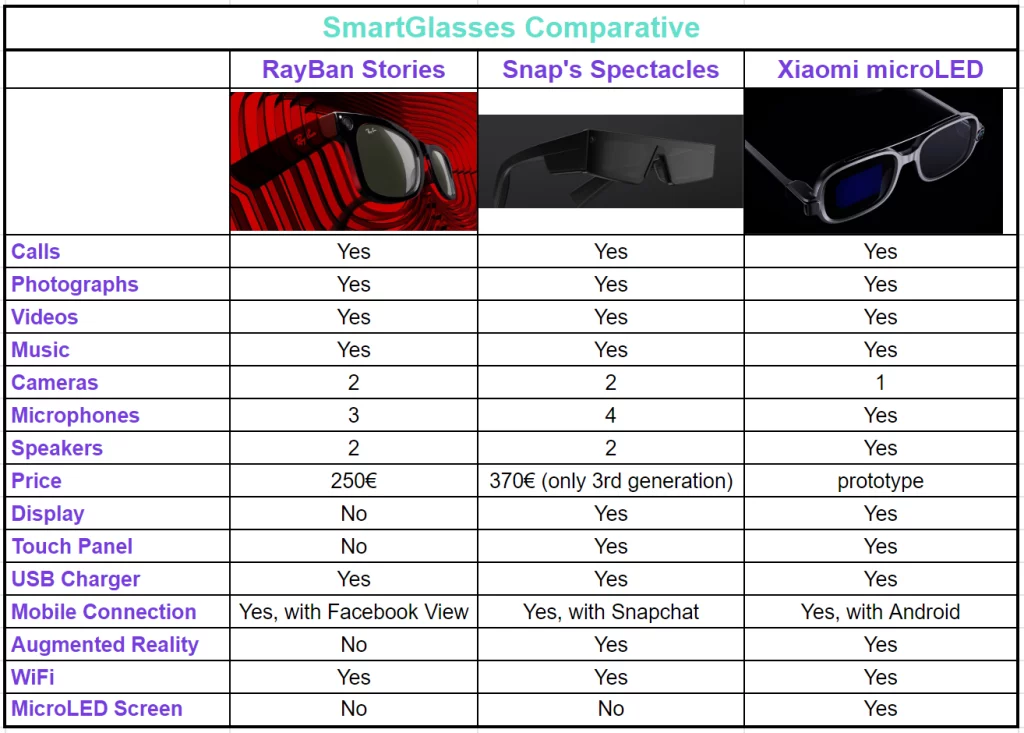These days, Meta (Facebook) and Snapchat maintain a fight for the SmartGlasses market. Specifically for smartglasses that allow content to be easily captured and published. Now Xiaomi has joined this fight. Meta first try with this kind of SmartGlasses are the RayBan Stories, which allow you to capture photos and videos, make calls and play music. Snapchat’s are Snap’s Spectacles that in their fourth generation can reproduce Augmented Reality. The Xiaomi SmartGlasses prototype stands out for its microLED screen that also allows viewing content in Augmented Reality while the user observes the environment.
RAY BAN STORIES
The RayBanStories are Facebook‘s first smartglasses that record videos and make calls. They allow you to take photos, answer calls and play music without having to take your mobile out of your pocket. They have two cameras, three microphones and speakers on their pins. In the market they are sold for about € 250.

Marck Zuckerberg (CEO of Meta, previously Facebook), explained in the glasses presentation that there will no longer be a choice between interacting with the device and interacting with the world around you. Facebook has been working for years on virtual and augmented reality glasses and even bracelets capables of interacting with these devices.
But the technological giant ultimate goal is to go further: it wants to create lenses that allow us to enter the metaverse, a virtual space in which users can interact with each other, entertain themselves or even go shopping.
Ray-Ban Stories development, according to Zuckerberg, “is an important step on the road to developing augmented reality glasses.” Even so, he warns: “There is still a lot of technology that needs to be developed and minimized to launch the augmented reality glasses that we all imagine for the future.”
SNAP SPECTACLES
Snapchat SnapSpectacles have a dual waveguide display capable of superimposing Augmented Reality effects made with Snapchat software. They define it as “Discovering new ways to combine fun and usefulness through immersive augmented reality, is to create AR in AR”. Due to its dual 3D waveguide display and 26.3-degree diagonal view field, the immersive augmented reality glasses overlap the world in front of your eyes. The screen adjusts dynamically so you can use them indoors or outdoors.

They have four microphones, two stereo speakers, a touch panel, and two front cameras. The main drawback is that they are not for sale, since they are designed for creators who seek to exceed the immersive experiences limits with Augmented Reality. You can only buy the third generation for € 370.
XIAOMI MICROLED
The prototype that Xiaomi has presented are smart Augmented Reality glasses that stand out for a microLED screen as an AR viewer that will allow you to view content while the user observes the environment. At the moment, it is a prototype, it is not a product that will be marketed soon.

Xiaomi smart glasses work with Wi-Fi and are not a complement to the smartphone, but are designed to work independently. The built-in microLED display allows you to view notifications and incoming calls, and has the ability to translate signs text or navigation with directions in real time and based on the environment.
These smart glasses can also perform the most mobile common tasks, as make or answer calls, listen to music, take pictures, etc. They can be controlled by voice or by pressing the sensors located on the pins. Xiaomi has distributed a total of 497 components for the frame and smart glasses lenses, which include an ARM quad-core processor, a 5 megapixel camera to take pictures or record video, speakers, microphones and a microLED screen located on one of the lenses. According to Xiaomi reports, they implement “a large miniature sensors number and communication modules, so they are not a simple second screen for your smartphone, but rather function as a new smart terminal.”

These devices open the door to a wide range of innovative experiences. Get in touch with us to ask about your next project.




